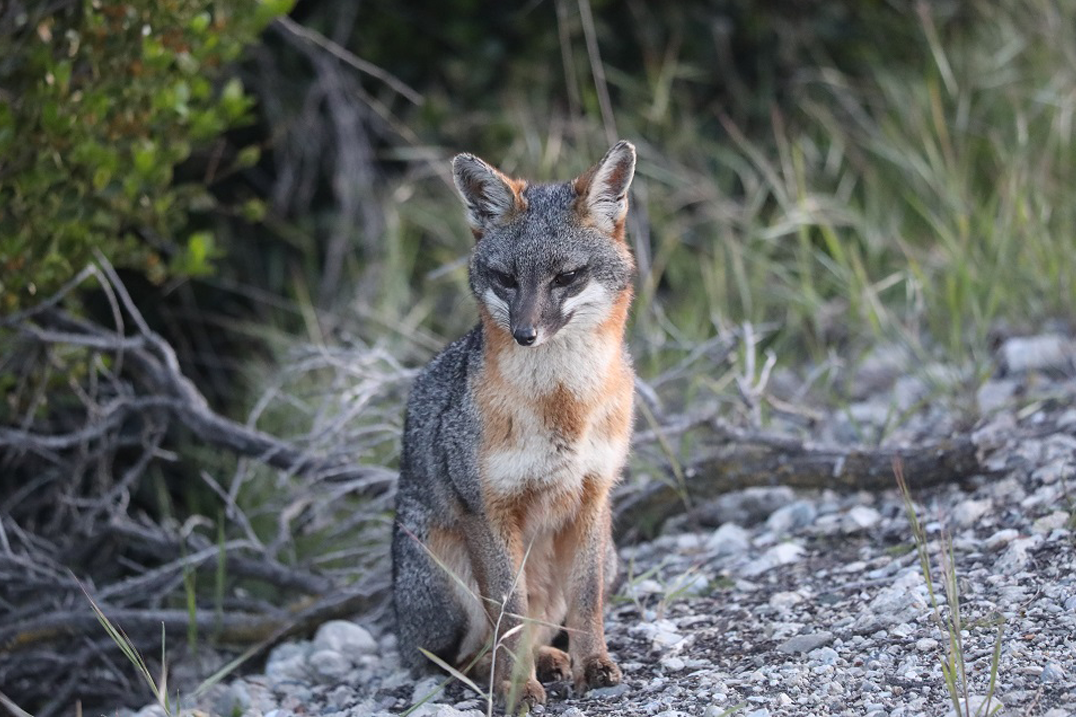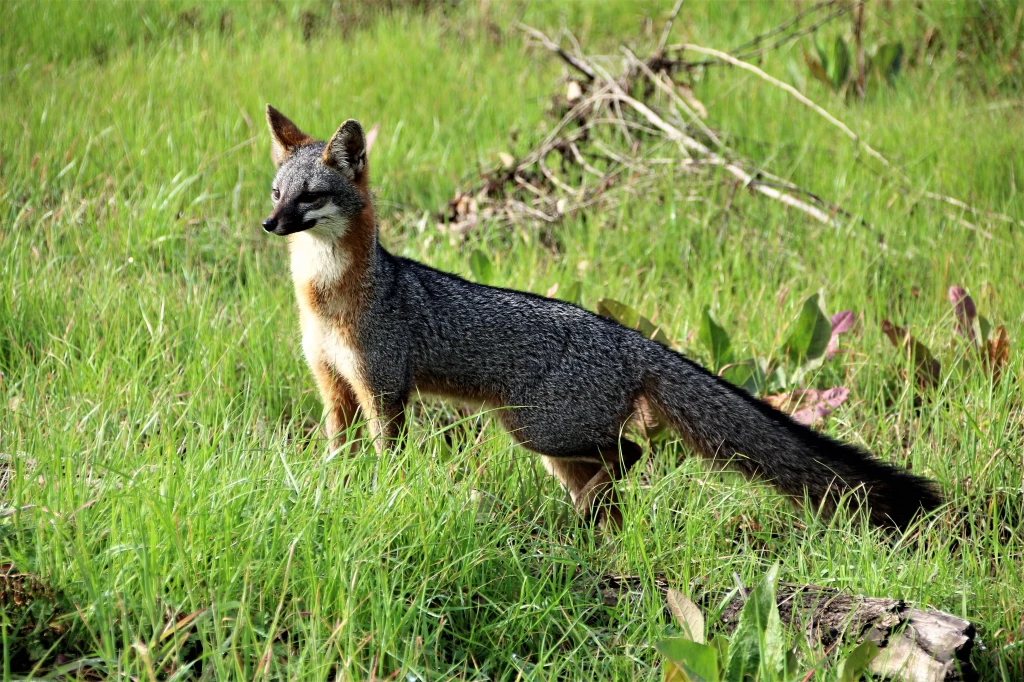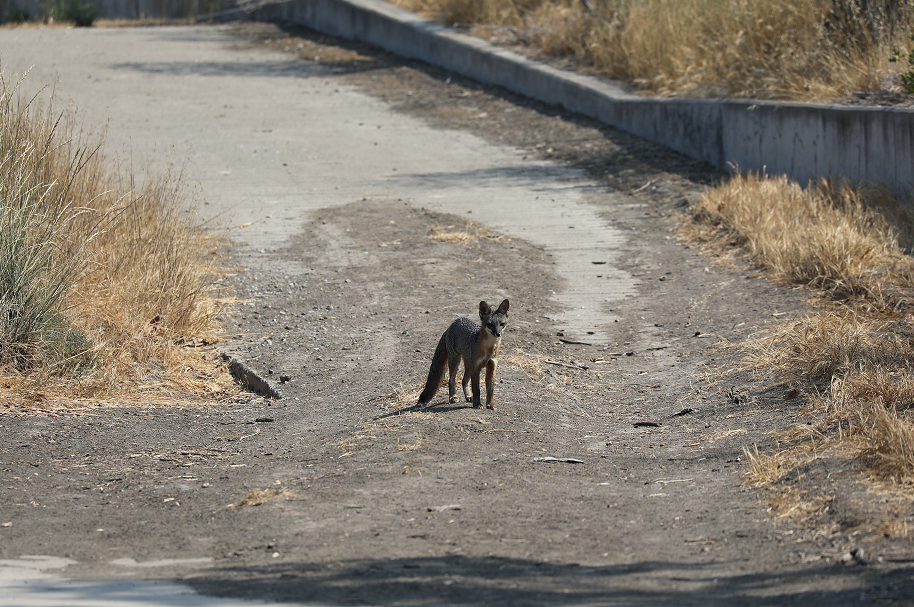Gray Fox: Shifting Behavior, Coloration, and Time
by William C. Leikam
President, CEO & Co-founder, Urban Wildlife Research Project
Is the usual wide spread color description of the gray fox (Urocyon cinereoargenteus townsendi) accurate? I mean, are such descriptions real? According to Wikipedia, “The gray fox displays white on the ears, throat, chest, belly, and hind legs. Gray foxes also have black around their eyes, on the lips, and on their noses.” They also have a rusty red color around their ears, part of their chest, legs and along the underbelly. This is the typical color description of these foxes.
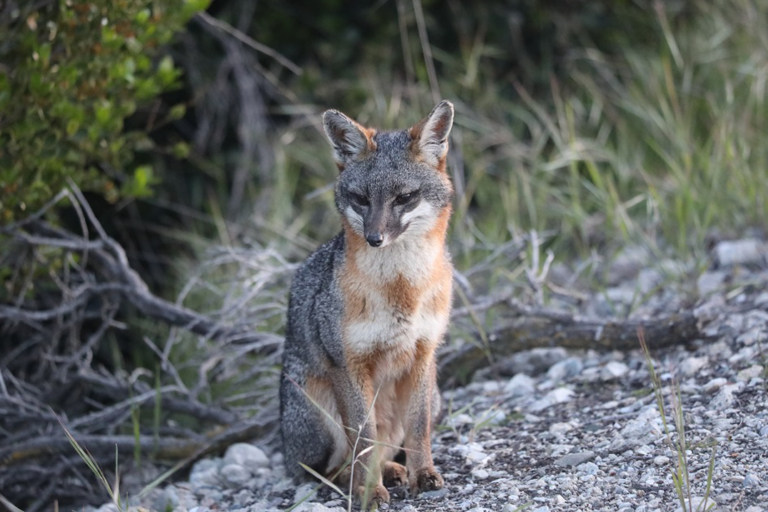
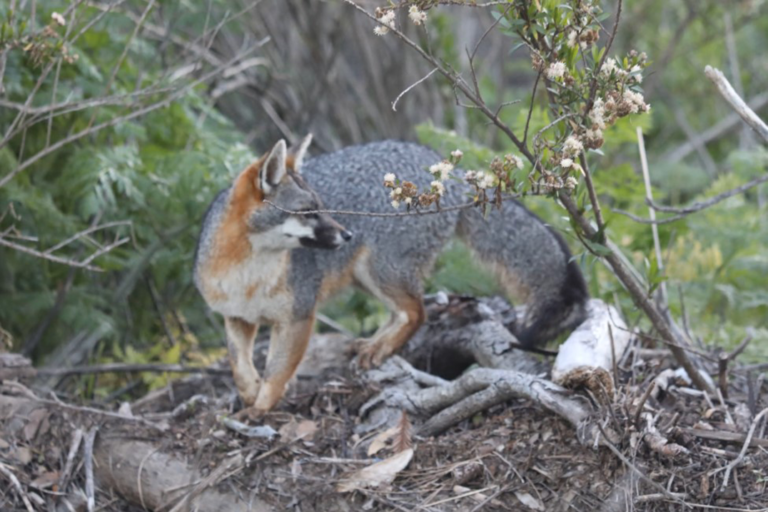
On changing color:
The foregoing description feels static, unchanging. but that’s not the case with all gray foxes, most importantly the females. During my study of gray fox behavior, I have seen several gray foxes over the course of seasons, shift their coloration from a dominant dark color over to a much grayer coloration. There are some like Mama Bold that all through the seasons she shifted her coloration from a rusty reddish color around her ears to a paler gray when she was pregnant. There are others that are grayer in the areas where they are expected to be rusty colored. That was the reason I named Mama Bold’s mate Gray.
Ever since late February and early March the gray fox female Big Eyes’ coloration has changed. She’s lighter colored and has lost a lot of that rusty red around her ears and down both front legs. Where she should be dark colored about her face, especially her snout, she is grayer and her behavior has changed.
On shifting behavior:
Prior to February Big Eyes routinely came to the edge of the brush near channel marker number 17, sat there on the berm and watch me as I took photos of her. Moving on into March, she no longer did so. She seldom showed up and when she did, if I took even a single step toward her, she’d skittishly dash back into the thicket.
I wondered about why at only certain times of the year and especially during late February and into March why I saw these changes. In giving the question some thought, it occurred to me that these changes always occurred the same time each year. It was the time of year when her hormones began to shift as her body and emotions prepared her to have pups. So, when Big Eyes makes for these preparations, her color shifts slightly and she becomes hyper-skittish because her life depends upon her living long enough to give birth to her pups and with mate Laimos’ help, to raise them
On time:
Along with such changes, as we move toward spring, daylight remains longer. The foxes and other critters along the creek “tell time” by the length of daylight to darkness. They are constantly cycling along on the duration of light and dark. By the time that Big Eyes should be having her young in mid-April, daylight approaches the longest day of the year on June 21st. That means that the nights are short and the adult foxes have to conduct a crash course in survival training for their pups.
So, shifting color to a lighter gray, shifting behavior from being relaxed to skittish, and shifting time all play an interconnected role with the female gray foxes at this time of year.
I. Gray Fox Population & General Health
As of this date, we have two adult gray foxes living in the Palo Alto Baylands Nature Preserve. These two foxes appear to be in good health. There is no indication in their scat that anything internal is breaking down.
II. UWRP News & Updates
Stay In Touch: Check us out on YouTube, Facebook, and LinkedIn to stay in the loop on our conservation activity, event announcements, and updates from gray foxes Big Eyes and Laimos in the Palo Alto Baylands!
Upcoming Event: On April 22nd, 2023, Bill Leikam “The Fox Guy” will be tabling at Safari West in Santa Rosa! Be sure to stop by between 10:00 AM and 3:00 PM if you’re free this upcoming Earth Day.
Coming Soon: Our website is currently under construction! We are so excited to unveil the overhauled site later this month.
Coming Soon: Look forward to a soon-to-be released video documentary about Bill’s participation in the global research project Triggered By Motion, and his once-in-a-lifetime opportunity to travel all the way from California to Zürich, Switzerland, to see the breathtaking exhibition in person.
Coming Soon: Bill is getting ready to be interviewed by Dr. Annabelle Dufourcq, Associate Professor of Metaphysics and philosophical anthropology, Philosophy, Theology and Religious Studies at Radboud University Nijmegen, The Netherlands — for a project of hers on ethology.
In The News: We’ve made a new discovery and documented the first beavers to occupy Matadero Creek in 160 years. Palo Alto Weekly, the San Jose Mercury News, and the Santa Cruz Sentinel. This story was syndicated nationally.
Available Now: Bill’s book The Road to Fox Hollow has been released and can be found at Barnes & Noble Booksellers and directly from the publisher Di Angelo Publications.
Available Now: Learn more about Bill’s work with the foxes in The Foxes, My Professors, a video documentary produced at Stanford University by Syler P.R.
Available Now: Learn more about The Social and Emotional Lives of Urban Gray Foxes in an interview with Bill conducted by Dr. Marc Bekoff on Psychology Today.
Available Now: Learn more about Bill’s ethological approach to his study of the gray fox in Bay Nature Magazine’s How to be a Fox. Many are calling this a major article in the wildlife press.
Available Now: Listen to our undoubtedly best radio interview ever: Bay Area Wildlife Habitats Are Disappearing. Fox Guy Has A Plan on KALW (PBS program Crosscurrents) by Sofie Kodner.
III. UWRP Research Objectives
Within the permit that allows the Urban Wildlife Research Project to conduct its study of the behavior of the gray fox at the Palo Alto Baylands Nature Preserve, the objectives covered area:
Monitoring of urban gray fox denning sites in Palo Alto Baylands: This is being accomplished during the period when the gray foxes use a den site. It is one of the prime locations for gathering most of the behavioral data of the litter and for adults alike.
Assessment of status and population trends of Baylands urban gray foxes: Since January 2019 a pair of resident gray foxes have claimed territory at the Palo Alto Baylands Nature Preserve.
Identification of habitat features that promote the presence of urban gray foxes: After considering this and talking with people who know how to restore habitats, we need to assess what kinds of plants, including the Alkaline Saltbush, would grow best along the edge of the saltwater channel and alongside the marsh. We need to grow a permanent habitat that contains the corridors and plant it as soon as possible. We’ll keep an eye on this as this is a critical link between the southern region of the Baylands and the northern region.
Assessment of reproductive success and identification of factors that promote successful reproduction: Open the pinch-point along Matadero Creek by developing thickets that link one area to another, instead of the present “islands”.
Identification and assessment of possible dispersal travel routes: Dispersal routes move between the Palo Alto Baylands Nature Preserve and the Shoreline region over in Mountain View. In a north-westerly direction the dispersal corridors run just behind the homes bordering the marshlands.

